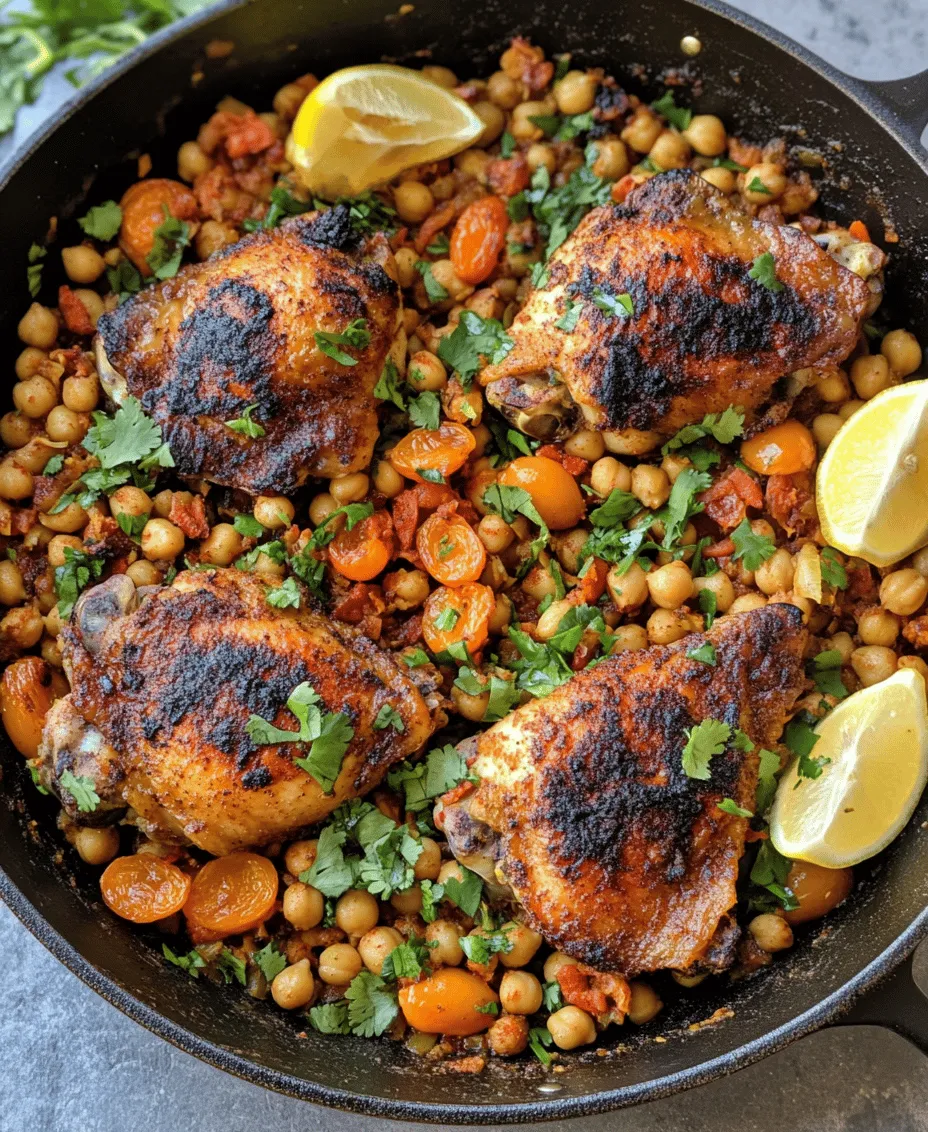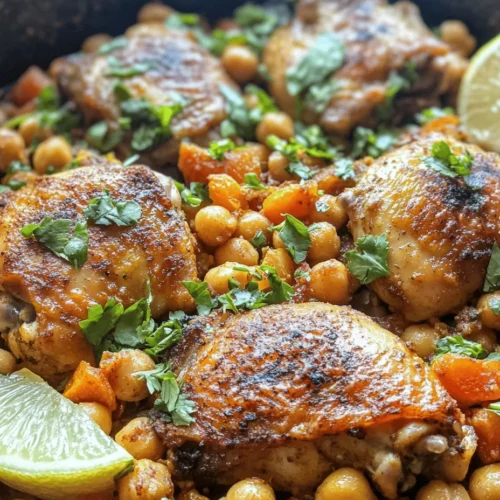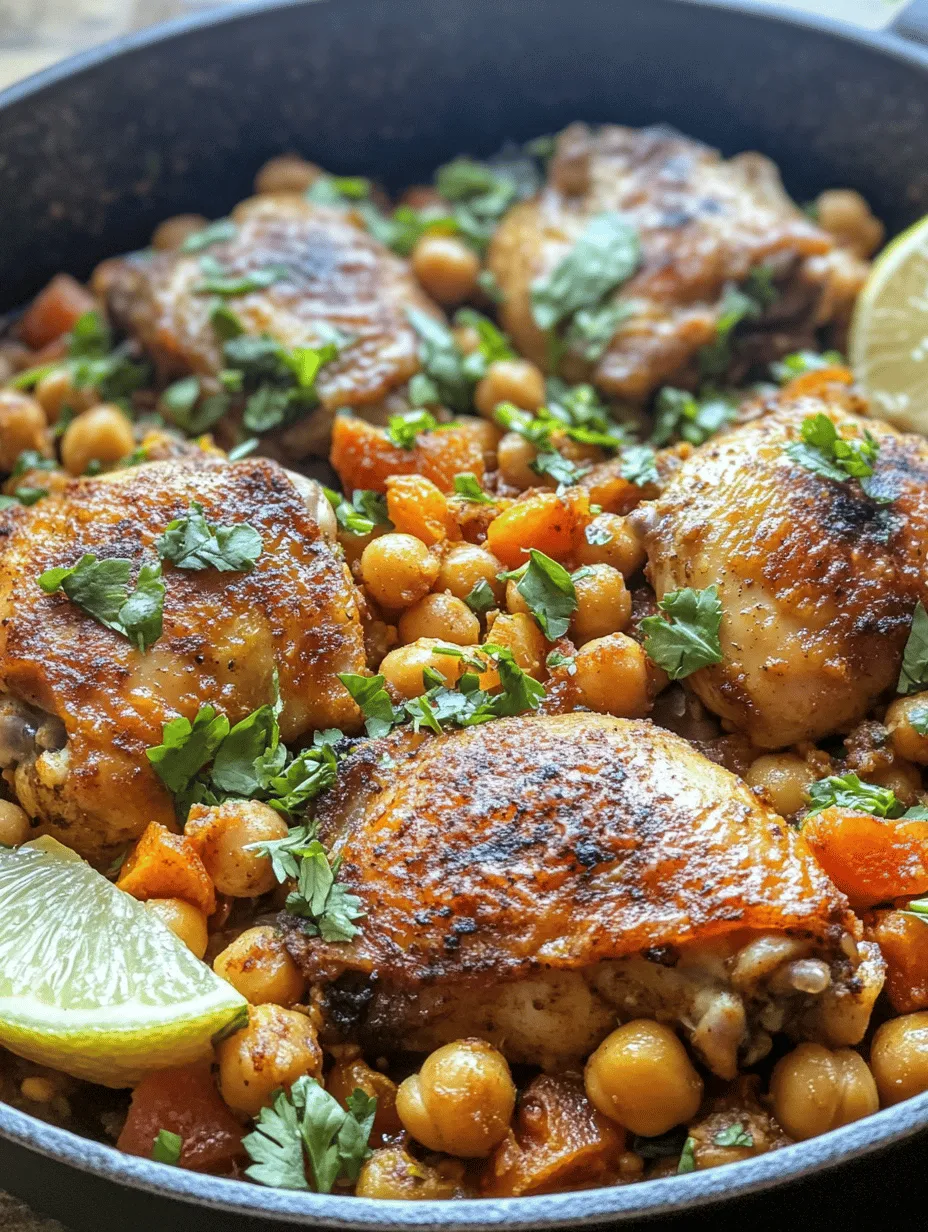Introduction
Moroccan cuisine is a vibrant tapestry of flavors, colors, and aromas that reflect the rich history and cultural influences of North Africa. It combines Berber, Arab, and Mediterranean elements, giving rise to a culinary tradition renowned for its use of fragrant spices and fresh ingredients. One dish that epitomizes this exquisite blend of flavors is Moroccan Spiced Chicken. This dish is not only a feast for the senses but also versatile enough to suit various occasions—whether it’s a cozy family dinner, a festive gathering, or an impressive dish to serve at a dinner party.
The Moroccan Spiced Chicken recipe is a celebration of spices that transports your taste buds to the bustling markets of Marrakech, where the air is filled with the scent of spices and grilled meats. Marinated in a blend of aromatic spices, this chicken dish is succulent, tender, and bursting with flavor. In this article, we will explore the essence of Moroccan cuisine, the spices that make this dish special, and guide you through the steps to create this culinary delight in your own kitchen.
Understanding Moroccan Spices
At the heart of Moroccan cooking lies a diverse array of spices that not only enhance the flavor of dishes but also contribute to their health benefits. The Moroccan Spiced Chicken recipe features a harmonious blend of spices, each playing a vital role in creating the dish’s signature taste. Here are some key spices commonly used in this recipe:
1. Cumin: This earthy spice has a warm, nutty flavor and is a staple in Moroccan cuisine. Cumin aids digestion and is rich in antioxidants.
2. Coriander: With its citrusy undertones, coriander adds brightness to the dish. It is known for its anti-inflammatory properties and can help lower blood sugar levels.
3. Paprika: This spice provides a subtle sweetness and vibrant color. Paprika is loaded with vitamins A and E, which are essential for healthy skin and vision.
4. Cinnamon: Often associated with sweet dishes, cinnamon also lends warmth to savory recipes. It has been linked to improved heart health and reduced inflammation.
5. Ginger: Fresh ginger adds a zesty kick and is well-known for its digestive benefits and anti-nausea properties.
6. Turmeric: This golden spice not only adds color but also has potent anti-inflammatory and antioxidant effects.
These spices are the backbone of Moroccan cooking, highlighting the importance of flavor profiles while offering numerous health benefits. Their combination results in a dish that is not only delicious but also nutritious.
Ingredients Overview
Creating a memorable Moroccan Spiced Chicken begins with selecting the right ingredients. Here’s a detailed list of the main ingredients you’ll need for this recipe, along with their significance in enhancing flavor:
Main Ingredients
– Chicken: Opt for bone-in, skin-on chicken thighs or drumsticks for the best flavor and moisture retention during cooking. Chicken breasts can also be used for a leaner option.
– Olive Oil: This healthy fat is essential for marinating the chicken and sautéing aromatics. It adds richness and depth to the dish.
– Onion: A foundational ingredient in many cuisines, onions provide sweetness and depth of flavor when sautéed.
– Garlic: Fresh garlic adds an aromatic punch and complements the spices beautifully.
– Lemon: Fresh lemon juice brightens the dish and balances the warmth of the spices.
– Honey: A touch of honey adds sweetness and enhances caramelization during cooking.
Key Spices
– Cumin
– Coriander
– Paprika
– Cinnamon
– Ginger
– Turmeric
– Salt and Pepper: Essential for enhancing the overall flavor of the dish.
Optional Ingredients
– Dried Fruits: Such as apricots or raisins can be added for a sweet contrast.
– Almonds or Pine Nuts: Toasted nuts add texture and richness.
– Fresh Herbs: Such as cilantro or parsley, for garnish and freshness.
Each ingredient plays a crucial role in building the dish’s flavor profile, while optional ingredients allow for personal touches that can elevate your Moroccan Spiced Chicken experience.
Marinating the Chicken
Marination is a crucial step in developing the flavors and tenderness of the chicken. For Moroccan Spiced Chicken, the marination process involves combining the spices, olive oil, lemon juice, and honey to create a flavorful paste. Here’s how to effectively marinate the chicken:
1. Prepare the Marinade: In a mixing bowl, combine olive oil, minced garlic, lemon juice, honey, and the blend of spices. Stir well to create a smooth paste.
2. Coat the Chicken: Place the chicken pieces in a large resealable plastic bag or a shallow dish. Pour the marinade over the chicken, ensuring that each piece is well-coated.
3. Marination Time: For optimal flavor, allow the chicken to marinate for at least 2 hours. If possible, marinate overnight in the refrigerator. This extended time allows the spices to penetrate the meat, enhancing both flavor and tenderness.
4. Room Temperature Before Cooking: Before cooking, let the marinated chicken sit at room temperature for about 30 minutes. This helps in even cooking.
By marinating the chicken, you not only infuse it with the vibrant flavors of the spices but also ensure that it remains juicy and tender throughout the cooking process.
Searing the Chicken
One of the defining techniques in this recipe is the searing of the chicken, which develops a rich, caramelized crust and enhances the overall flavor. Here’s how to achieve the perfect sear:
1. Choose the Right Pan: A heavy-bottomed skillet or a tagine is ideal for searing chicken. The even heat distribution helps achieve a golden crust without burning.
2. Preheat the Pan: Heat your skillet over medium-high heat and add a splash of olive oil. Allow the oil to heat until shimmering but not smoking.
3. Add the Chicken: Carefully place the marinated chicken pieces in the hot skillet, skin-side down. Avoid overcrowding the pan to ensure even cooking.
4. Visual Cues for Perfect Searing: Let the chicken cook undisturbed for about 5-7 minutes, or until the skin is golden brown and releases easily from the pan. Flip the chicken and sear the other side for another 5-7 minutes. The key is to develop that rich, flavorful crust.
5. Remove and Set Aside: Once seared, remove the chicken from the skillet and set it aside. This step is crucial, as it locks in moisture and allows the chicken to finish cooking in the sauce later.
The searing process not only adds depth of flavor to the chicken but also enhances the overall presentation of the dish.
Sautéing Aromatics
Building flavor through sautéing aromatics is an essential step in creating a delicious Moroccan Spiced Chicken. The combination of onions and garlic adds a robust base to the dish. Here’s how to sauté these ingredients effectively:
1. Sauté the Onions: In the same skillet used for searing the chicken, add a bit more olive oil if needed. Lower the heat to medium and add finely chopped onions. Stir frequently to ensure even cooking.
2. Cook Until Translucent: Aim for the onions to become soft and translucent, which usually takes about 5-7 minutes. This process brings out the natural sweetness of the onions.
3. Add Garlic: Once the onions are translucent, add minced garlic to the pan. Garlic cooks quickly, so sauté for about 1-2 minutes until fragrant. Be cautious not to let it burn, as burnt garlic can impart a bitter taste.
4. Building Flavor: At this stage, you can also add the remaining marinade to the skillet, scraping up any browned bits left in the pan (these bits are packed with flavor). This step creates a delicious base for the chicken to simmer in.
By carefully sautéing the onions and garlic, you set the stage for a rich, flavorful sauce that will envelop the chicken as it cooks, enhancing the overall taste of the dish.
As you continue with the recipe, you’ll find that each step contributes to the complexity and depth of flavors characteristic of Moroccan cuisine. The careful selection of spices, marination, and cooking techniques will ensure a delightful dining experience that brings a taste of Morocco right to your table.

Integrating Broth, Chickpeas, and Apricots
To create a truly memorable Moroccan Spiced Chicken, the integration of broth, chickpeas, and dried apricots is essential. Start by adding your chicken pieces to the pot, allowing them to absorb the aromatic spices you’ve already introduced. Next, pour in the chicken broth, ensuring that the liquid covers the chicken sufficiently. The broth serves as a flavorful base, enriching the dish and ensuring that each bite is infused with depth.
Chickpeas play a dual role in this recipe—they add protein and fiber, enhancing the nutritional value while also contributing a delightful texture. When cooked, chickpeas become tender yet retain a slight bite, creating a satisfying contrast to the soft chicken. As for the dried apricots, their natural sweetness pairs beautifully with the spices, balancing flavors and adding a hint of tartness once cooked. As the dish simmers, the apricots will plump up, releasing their juices and further enriching the broth.
The Importance of Simmering for Flavor Melding
A key aspect of achieving the best flavors in your Moroccan Spiced Chicken is the simmering process. Allowing the dish to simmer for a sufficient amount of time enables the spices to meld together harmoniously, enhancing the overall taste. Bring the mixture to a gentle boil, then reduce the heat to low, covering the pot. This slow cooking method allows for the chicken to absorb the rich flavors from the broth and spices while the chickpeas and apricots contribute their unique tastes.
Ideally, you should let the dish simmer for at least 45 minutes to 1 hour. During this time, the chicken will become tender, soaking up the spices and flavors. To check for doneness, pierce the thickest part of the chicken with a fork or knife; the juices should run clear, indicating that it is fully cooked. The texture should be melt-in-your-mouth tender, ensuring a delightful dining experience.
Slow Cooking for Tenderness
Slow cooking is a technique that deserves special attention in this recipe, as it transforms the chicken into a tender, flavorful masterpiece. The ideal cooking temperature for slow-cooked chicken is around 165°F (74°C), and the cooking time can vary depending on the size of the chicken pieces and the heat of your stovetop. Generally, a low and slow approach is best, allowing the chicken to cook evenly and thoroughly.
To achieve the perfect tenderness, consider using a slow cooker or a Dutch oven. If you’re using a slow cooker, set it to low for 6 to 8 hours or high for 3 to 4 hours. For a Dutch oven on the stovetop, maintain a low simmer for 1 to 1.5 hours. Regardless of your method, check the chicken periodically to ensure it doesn’t overcook, as this can lead to dryness. When the chicken is done, it should easily pull away from the bone, showcasing its succulent texture.
Finishing Touches
As your Moroccan Spiced Chicken nears completion, it’s time to incorporate finishing touches that will elevate the dish further. Toasted almonds are a fantastic addition, providing a delightful crunch that contrasts beautifully with the tender chicken and soft chickpeas. To toast almonds, simply place them in a dry skillet over medium heat, stirring frequently until golden brown and fragrant. This process usually takes about 5-7 minutes.
Before serving, taste the dish and adjust the seasoning as needed. A pinch of salt or a squeeze of fresh lemon juice can brighten the flavors, ensuring that each element shines. For a burst of color and freshness, garnish the dish with chopped fresh herbs, such as cilantro or parsley. Not only do these herbs enhance the visual appeal, but they also add a fresh flavor that complements the spiced chicken perfectly.
Serving Suggestions
When it comes to serving Moroccan Spiced Chicken, consider pairing it with traditional accompaniments that enhance the meal’s cultural authenticity. Couscous is a classic choice, soaking up the rich sauce and providing a fluffy texture that balances the dish. Alternatively, warm pita bread can be served on the side, perfect for sopping up the delicious sauce.
For presentation, serve the chicken on a large platter, surrounded by the chickpeas and apricots, and sprinkle with toasted almonds and fresh herbs for a vibrant look. A colorful salad, such as a Moroccan carrot salad with citrus dressing, can add a refreshing crunch to the meal.
To complete the dining experience, consider pairing the dish with a light, fruity beverage. Mint tea, a staple in Moroccan culture, is an excellent choice, as its refreshing flavor complements the spices beautifully. If you prefer something non-caffeinated, a sparkling water infused with citrus or berries can also enhance your meal.
Nutritional Information
Moroccan Spiced Chicken not only delights your taste buds but also offers a variety of nutritional benefits. This dish is rich in protein due to the chicken and chickpeas, making it a satisfying option for those looking to maintain a balanced diet. Chickpeas also provide dietary fiber, which is essential for digestive health.
In terms of calorie count, a serving of Moroccan Spiced Chicken (approximately 1 cup) contains around 350-400 calories, depending on the specific ingredients used. The macronutrient breakdown typically includes 25-30 grams of protein, 15-20 grams of carbohydrates, and 10-15 grams of fat, making it a well-rounded meal option.
For those with dietary restrictions, there are several modifications you can consider. To make it gluten-free, ensure your broth is gluten-free and serve it with quinoa instead of couscous. For a lower-calorie option, you might reduce the amount of oil used in cooking or serve smaller portions alongside a hearty salad.
Cultural Significance
Chicken dishes hold a significant place in Moroccan culture, often served during special occasions and family gatherings. This Moroccan Spiced Chicken recipe reflects traditional Moroccan cooking practices, where spices and fresh ingredients are celebrated. The communal aspect of Moroccan meals is vital; dishes are often served family-style, encouraging sharing and connection over food.
The use of spices such as cumin, coriander, and cinnamon in this recipe showcases the influence of trade routes that have historically passed through Morocco, bringing diverse flavors to the region. This dish not only serves as a delicious meal but also as a representation of Morocco’s rich culinary heritage.
Conclusion
In summary, Moroccan Spiced Chicken is a dish that embodies the soul of Moroccan cuisine—rich in flavor, texture, and tradition. With its harmonious blend of spices, tender chicken, and sweet apricots, this recipe is sure to impress your family and friends. Whether you’re exploring new culinary horizons or looking to share a comforting meal with loved ones, this dish provides a delightful experience.
As you venture into the world of Moroccan cooking, don’t hesitate to try this recipe and discover the joy of creating and sharing meals infused with cultural significance. Cooking is not just about nourishment; it’s about connection, tradition, and the happiness that comes from gathering around a table filled with delicious food. Enjoy your culinary journey and the flavors of Morocco!



